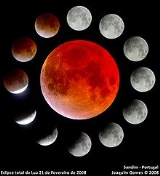
February 2008 lunar eclipse
Encyclopedia
A total lunar eclipse
occurred on the evening of Wednesday, February 20, and morning of Thursday, February 21, 2008. It was visible in the eastern evening sky on February 20 for all of North
and South America, and on February 21 in the predawn western sky from most of Africa and Europe.
The total lunar eclipse was the first of the two lunar eclipses in 2008, with the second, the August 16, 2008
event being partial. The next total lunar eclipse occurred on December 21, 2010
.
The penumbral eclipse began at 00:35 UTC (February 21), and ended at 6:17. A partial eclipse existed from 1:43 until 3:00, followed by 51 minutes of totality (3:00 - 3:51), and then partial again from 3:51 until 5:09. (For local times, see Timing.)
It is possible to mistake the appearance of partial eclipse as the moon being in a different phase
, but the shadow from the eclipse changes much more rapidly.
The bright star Regulus
of Leo
and the planet Saturn
were prominent very near the moon during the total eclipse portion. Shortly before the eclipse began, Regulus was occulted
by the moon in parts of the far Southern Atlantic ocean and Antarctica.
, which repeats every 18 years and 11 days. Series 133 runs from the year 1557 until 2819. The previous eclipse of this series occurred on February 9, 1990 and the next will occur on March 3, 2026.
It is the 6th of 21 total lunar eclipses in series 133. The first was on December 28, 1917. The last (21st) will be on August 3, 2278. The longest two occurrences of this series (14th and 15th) will last for a total of 1 hour and 42 minutes on May 18, 2152 and May 30, 2170.
at 1:43. Totality lasted for 51 minutes, between 3:01 and 3:52. The moon left the umbra shadow at 5:09 and left the penumbra shadow at 6:17.
Lunar eclipse
A lunar eclipse occurs when the Moon passes behind the Earth so that the Earth blocks the Sun's rays from striking the Moon. This can occur only when the Sun, Earth, and Moon are aligned exactly, or very closely so, with the Earth in the middle. Hence, a lunar eclipse can only occur the night of a...
occurred on the evening of Wednesday, February 20, and morning of Thursday, February 21, 2008. It was visible in the eastern evening sky on February 20 for all of North
North America
North America is a continent wholly within the Northern Hemisphere and almost wholly within the Western Hemisphere. It is also considered a northern subcontinent of the Americas...
and South America, and on February 21 in the predawn western sky from most of Africa and Europe.
The total lunar eclipse was the first of the two lunar eclipses in 2008, with the second, the August 16, 2008
August 2008 lunar eclipse
A partial lunar eclipse took place on August 16, 2008, the second of two lunar eclipses in 2008, with the first being a total eclipse on February 20, 2008...
event being partial. The next total lunar eclipse occurred on December 21, 2010
December 2010 lunar eclipse
The December 2010 lunar eclipse occurred from 5:27 to 11:06 UTC on December 21, coinciding with the date of the December solstice. It was visible in its entirety as a total lunar eclipse in North and South America, Iceland, Ireland, Britain and northern Scandinavia.-Occurrence:The eclipse of...
.
Viewing
The eclipse was visible in the eastern evening sky on February 20 for all of North and South America, and on February 21 in the predawn western sky from most of Africa and Europe.The penumbral eclipse began at 00:35 UTC (February 21), and ended at 6:17. A partial eclipse existed from 1:43 until 3:00, followed by 51 minutes of totality (3:00 - 3:51), and then partial again from 3:51 until 5:09. (For local times, see Timing.)
It is possible to mistake the appearance of partial eclipse as the moon being in a different phase
Lunar phase
A lunar phase or phase of the moon is the appearance of the illuminated portion of the Moon as seen by an observer, usually on Earth. The lunar phases change cyclically as the Moon orbits the Earth, according to the changing relative positions of the Earth, Moon, and Sun...
, but the shadow from the eclipse changes much more rapidly.
The bright star Regulus
Regulus
Regulus is the brightest star in the constellation Leo and one of the brightest stars in the night sky, lying approximately 77.5 light years from Earth. Regulus is a multiple star system composed of four stars which are organized into two pairs...
of Leo
Leo (constellation)
Leo is one of the constellations of the zodiac. Its name is Latin for lion. Its symbol is . Leo lies between dim Cancer to the west and Virgo to the east.-Stars:...
and the planet Saturn
Saturn
Saturn is the sixth planet from the Sun and the second largest planet in the Solar System, after Jupiter. Saturn is named after the Roman god Saturn, equated to the Greek Cronus , the Babylonian Ninurta and the Hindu Shani. Saturn's astronomical symbol represents the Roman god's sickle.Saturn,...
were prominent very near the moon during the total eclipse portion. Shortly before the eclipse began, Regulus was occulted
Occultation
An occultation is an event that occurs when one object is hidden by another object that passes between it and the observer. The word is used in astronomy . It can also refer to any situation wherein an object in the foreground blocks from view an object in the background...
by the moon in parts of the far Southern Atlantic ocean and Antarctica.
Saros series
This lunar eclipse is part of series 133 of the Saros cycleSaros cycle
The saros is a period of 223 synodic months , that can be used to predict eclipses of the Sun and Moon. One saros after an eclipse, the Sun, Earth, and Moon return to approximately the same relative geometry, and a nearly identical eclipse will occur, in what is referred to as an eclipse cycle...
, which repeats every 18 years and 11 days. Series 133 runs from the year 1557 until 2819. The previous eclipse of this series occurred on February 9, 1990 and the next will occur on March 3, 2026.
It is the 6th of 21 total lunar eclipses in series 133. The first was on December 28, 1917. The last (21st) will be on August 3, 2278. The longest two occurrences of this series (14th and 15th) will last for a total of 1 hour and 42 minutes on May 18, 2152 and May 30, 2170.
Metonic cycle (19 years)
This is the fourth of five Metonic lunar eclipses.Timing
The moon entered the penumbral shadow at 00:35 UTC, and the umbral shadowUmbra
The umbra, penumbra and antumbra are the names given to three distinct parts of a shadow, created by any light source. For a point source only the umbra is cast.These names are most often used to refer to the shadows cast by celestial bodies....
at 1:43. Totality lasted for 51 minutes, between 3:01 and 3:52. The moon left the umbra shadow at 5:09 and left the penumbra shadow at 6:17.
| Event | North and South America | Europe and Africa | ||||||||
|---|---|---|---|---|---|---|---|---|---|---|
| Evening of February 20, 2008 | Morning of February 21, 2008 | |||||||||
| AKST (-9h) |
PST (-8h) |
MST (-7h) |
CST (-6h) |
EST (-5h) |
AST (-4h) |
GMT (0h) |
CET Central European Time Central European Time , used in most parts of the European Union, is a standard time that is 1 hour ahead of Coordinated Universal Time . The time offset from UTC can be written as +01:00... (+1h) |
EET Eastern European Time Eastern European Time is one of the names of UTC+02:00 time zone, 2 hours ahead of Coordinated Universal Time. It is used in some European countries that also use Eastern European Summer Time as a summer daylight saving time.- Usage :... (+2h) |
||
| U1 | Partial began | 15:43 | 16:43 | 17:43 | 18:43 | 19:43 | 20:43 | 01:43 | 02:43 | 03:43 |
| U2 | Total began | 17:01 | 18:01 | 19:01 | 20:01 | 21:01 | 22:01 | 03:01 | 04:01 | 05:01 |
| Mid-eclipse | 17:26 | 18:26 | 19:26 | 20:26 | 21:26 | 22:26 | 03:26 | 04:26 | 05:26 | |
| U3 | Total ended | 17:51 | 18:51 | 19:51 | 20:51 | 21:51 | 22:51 | 03:51 | 04:51 | 05:51 |
| U4 | Partial ended | 20:09 | 21:09 | 22:09 | 23:09 | 00:09 | 01:09 | 05:09 | 06:09 | 07:09 |
Composites
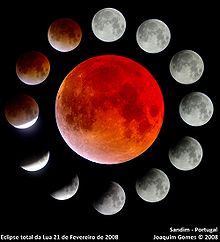 Eclipse observed from Sandim, Vila Nova de Gaia, Portugal. Lat:41º02'22" N Lon:8º30'50" W. |
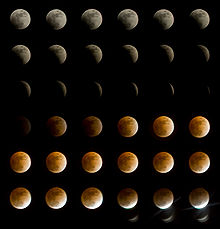 Eclipse observed from Regina, Saskatchewan Regina, Saskatchewan Regina is the capital city of the Canadian province of Saskatchewan. The city is the second-largest in the province and a cultural and commercial centre for southern Saskatchewan. It is governed by Regina City Council. Regina is the cathedral city of the Roman Catholic and Romanian Orthodox... , Canada. Each image is roughly taken 5 minutes apart. |
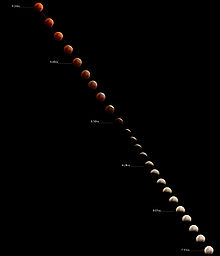 Images taken in 3-5 minute Intervals - from Bradley, Illinois Bradley, Illinois Bradley is a village in Kankakee County, Illinois, United States. The population was 12,784 at the 2000 census, and 15,070 in 2009.... . |
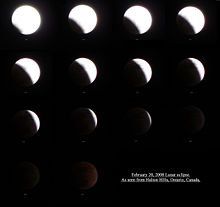 Eclipse observed from Halton Hills, Ontario Halton Hills, Ontario Halton Hills is a town in the Regional Municipality of Halton, west of Toronto, Ontario, Canada. It is located within the Greater Toronto Area.... , Canada. From 01:47 to 03:15 UTC, each image is roughly taken 5min apart. |
.jpg) Lunar eclipse observed from Tepic, Nayarit, Mexico. |
|
 Eclipse observed from Winnipeg, Manitoba, Canada |
||
 Lunar eclipse observed from Burlington, Ontario, Canada |
||
 Observed from Baltimore, MD, USA from 2:30 to 3:01 UTC. Lunar north is near left. |
||
See also
- List of lunar eclipses and List of 21st century lunar eclipses
- Solar eclipseSolar eclipseAs seen from the Earth, a solar eclipse occurs when the Moon passes between the Sun and the Earth, and the Moon fully or partially blocks the Sun as viewed from a location on Earth. This can happen only during a new moon, when the Sun and the Moon are in conjunction as seen from Earth. At least...
- :File:2008-02-21 Lunar Eclipse Sketch.gif Chart
External links
- NASA: Total Lunar Eclipse: February 20, 2008
- Hermit eclipse (Ian Cameron Smith) Total Lunar Eclipse: February 21, 2008
- Photos
- Astronet: Information and live webcasts of the February 20-21 total lunar eclipse from Holland, Belgium, Germany, Spain and Argentina
- NASA Astronomy Picture of the Day: February 20, 2008, February 22, 2008 March 1, 2008
- Sky&Telescope, Eclipses of 2008
- Example Images from Dr. Eric S. Ackerman - Fort Lauderdale, Florida
- Various Animations of the Eclipse Astronight Observatory - Billerica MA
- SpaceWeather Lunar Eclipse Photo Gallery: February 20, 2008
- Philadelphia, PA: A timelapse of the total lunar eclipse on February 20th, 2008. Recorded with still images.
- http://www.wunderground.com/wximage/viewsingleimage.html?mode=singleimage&handle=Monarch&number=84 http://icons-pe.wunderground.com/data/wximagenew/m/Monarch/84.jpg

